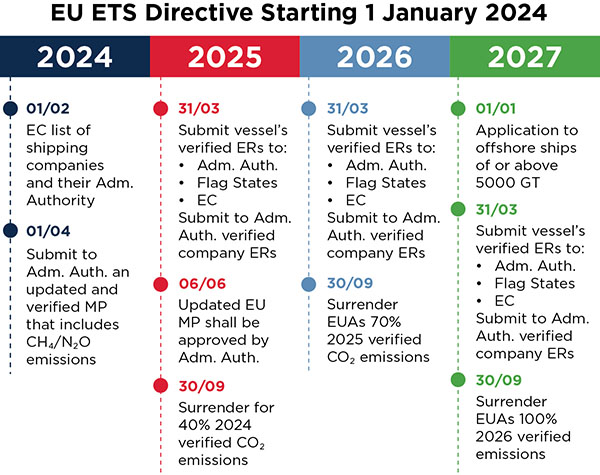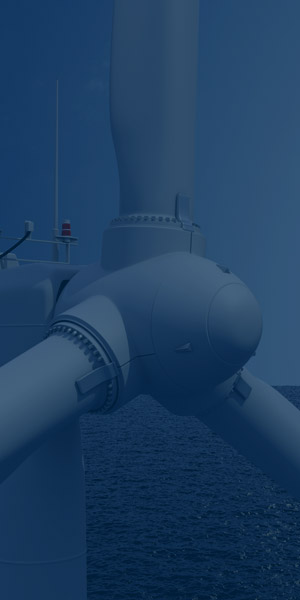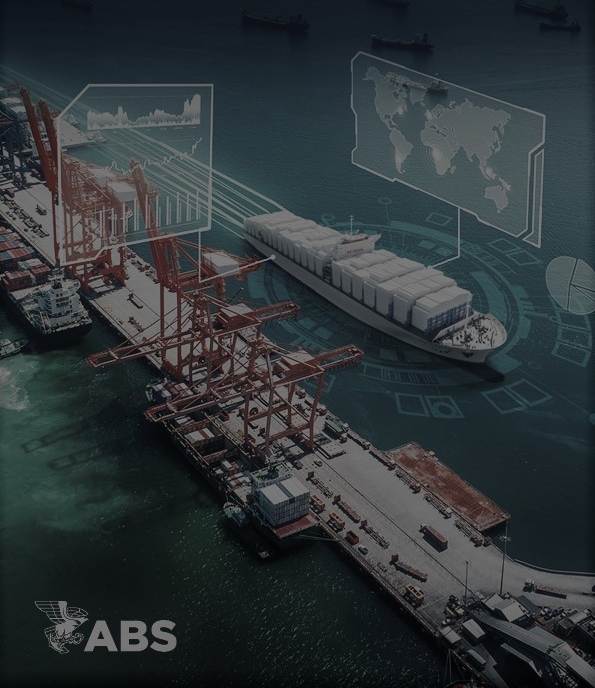Quick Links
- Overview
- Frequently Asked Questions
What is EU ETS?
EU ETS is a cap-and-trade system market-based-measure (MBM) for reducing greenhouse gas emissions (GHG), in the scope of the EU’s “Fit for 55” package. Starting from 2025, shipping companies will have to surrender sufficient EU emission allowances (EUAs) based on EU monitoring, reporting and verification (MRV) data of the previous year. It has two principles, setting a ceiling on the yearly maximum amount of GHG emissions and the trading of EU emission allowances.
What does EU ETS mean for shipping companies?
Shipping companies will have to purchase and surrender ETS emission allowances for each tonne of reported CO2 emissions from their fleet ships falling in the scope of the system. Shipping companies will be given an administering authority of a member State that will ensure compliance using the same rules as for the other sectors.
To ensure a smooth transition, according to the proposal, shipping companies will only have to surrender allowances for a portion of their emissions during an initial phase-in period, reaching 100% after 3 years.
Shipping companies that do not surrender the equivalent amount of EUAs based on their emissions will have to pay a penalty of 100 EUR per tonne CO2e. Payment of this penalty does not relieve the shipping company from the obligation to surrender the equivalent amount of EUAs in the next reporting period. To ensure a smooth transition, shipping companies will only have to surrender allowances for a portion of their emissions during an initial phase-in period, as follows:
- 40% of verified emissions in 2024
- 70% of verified emissions in 2025
- 100% of verified emissions in 2026
From 1 January 2024, they shall start monitoring based on their monitoring plan which shall be amended, verified and submitted to the responsible administering authority by 1 April 2024 to reflect the inclusion of CH4 and N2O emissions. By 31 March 2025 and onwards they shall report aggregated monitoring data at company level. By 30 September 2025 and onwards they shall surrender adequate allowances based on their reported aggregated emissions. For ships that fall under EU ETS for the first time after 1 January 2024 (e.g. if the vessel performs a “port of call” at a member State’s (MS) port for the first time in 2025) the shipping company shall submit a monitoring plan to the responsible administering authority without undue delay and no later than three months after each ship’s first call in a port under the jurisdiction of a MS.

How can ABS assist?
ABS shall assist with checking whether or not the submitted monitoring plan is in compliance. Furthermore, by 31 March 2025 and onwards we will assess the shipping company’s submitted data and issue a verification report. Finally, by 30 June 2025 and onwards ABS will issue a document of compliance for the shipping companies that have surrendered adequate allowances.
What emissions will be covered under EU ETS?
The necessary allowances will be based on the reported emissions under EU MRV. However, shipping companies will not have to surrender allowances for the total CO₂ emissions reported for the previous calendar year, but for:
- 100% of the emissions from ships performing voyages between EU ports
- 50% of the emissions from ships performing voyages departing from an EU port to a non-EU port
- 50% of the emissions from ships performing voyages departing from a non-EU port to an EU port
- 100% of the emissions from ships at berth in an EU port
Initially only CO₂ emissions will be covered. However, starting in 2024, CH₄ and N₂O will be included in the EU MRV and from 2026 in the EU ETS. As mentioned above by 1 April 2024, shipping companies shall submit to the responsible administering authority, a verified monitoring plan that reflects the inclusion of CH4 and N2O emissions.
What vessels will be covered?
Initially, EU ETS will cover CO₂ emissions generated from ships of 5,000 gross tonnes (GT) and above that call at EU ports. From January 2027, EU ETS will be extended to offshore vessels over 5,000 GT, which will be already included in the EU MRV from 2025 along with general cargo ships of 400 GT and above. For the latter, their inclusion in EU ETS will be reviewed no later than 2027.
Will EU ETS be applied to vessels that call on EU ports only?
The EU recognizes that due to the absence of a global market-based-measure (MBM) on shipping generated GHG emissions, the probability of EU port evasion is increased. In that order certain stops of containerships at non-EU container transhipment ports will be included in EU ETS which are in a vicinity of less than 300 nautical miles from the Union’s territory. By 31 December 2023, the Commission shall establish a list of container transhipment ports and update it by 31 December every two years thereafter.
Are shipping companies eligible for any exclusions from EU ETS?
Yes, under EU ETS shipping companies are eligible for surrendering fewer or no EUAs at all under the following four scenarios:
- Ice class ships
o Current design of ice class ships enabling them to sail in ice conditions that lead to an increased fuel consumption. Therefore, shipping companies may surrender 5% fewer EUAs than their verified emissions until 31 December 2030 from ice class ships, provided that these ships have ice class IA or IA Super or an equivalent ice class.
- Small islands
o Until 31 December 2030, member States may request from the Commission the exclusion of shipping companies from the obligation to surrender emissions from voyages performed by passenger ships, other than cruise passenger ships and by ro/pax ships, between the port of an island under the jurisdiction of the requesting member State and a port under the jurisdiction of that member State, provided that the island has a permanent population of less than 200,000 residents.
- Transnational public service connection between member States
o Until 31 December 2030, shipping companies may be excluded from the obligation to surrender allowances for the emissions arising from voyages by passenger or ro/pax ships performed in the framework of a transnational public service between a member State that has no land border with another member State and the other member State that is at the closest proximity to the first, at the joint request of these two member States.
- Outermost regions
o Until 31 December 2030, an obligation to surrender allowances shall not arise for the emissions generated during voyages between a port located in an outermost region of a member State and a port located in the same member State.
What are the obligations of shipping companies, verifiers and administering authorities?
- Shipping companies:
From 1 January 2024, they shall start monitoring based on their monitoring plan and by 31 March 2025 and onwards to report aggregated monitoring data at company level. By 1 April 2024 they shall submit to their administering authority a revised monitoring plan that has been assessed as being in conformity with the revised EU MRV Regulation by the verifier to reflect the inclusion of CH4 and N2O. By 30 September 2025 and onwards they shall surrender adequate allowances based on their reported aggregated emissions. For ships that fall under EU ETS for the first time after 1 January 2024, shipping companies shall submit a monitoring plan no later than three months after each ship’s first port of call in a MS.
- Verifiers:
The verifiers shall check whether or not the submitted monitoring plan is in compliance. Furthermore, by 31 March 2025 and onwards they shall assess the shipping company’s submitted data and issue a verification report.
- Administering authorities:
Administering authorities shall by 31 March 2025 and onwards, ensure that each shipping company’s submitted data is properly verified and by 30 September 2025 and onwards confirm that the shipping company has surrendered adequate allowances.
How will the revenues from EU ETS be used?
The revenues arising from EU ETS will fund investments such as:
- R&D and demonstration projects that aim to reduce GHG emissions;
- Development of renewable energies and other technologies that contribute to the transition to a safe and sustainable low-carbon economy;
- Environmentally safe carbon capture and storage;
- Measures intended to improve energy efficiency and clean technologies in the sectors covered by EU ETS.
Furthermore, each year until 2030 the revenue from the auction of 20 million allowances will be included in the Innovation Fund to support investments for the decarbonization of maritime sector and especially:
- Improvement of energy efficiency of ships, ports and short-sea shipping;
- Electrification of maritime sector;
- Investments in sustainable alternative fuels such as hydrogen and ammonia;
- Investments in zero-emission propulsion technologies e.g., wind propulsion
- Innovations to ice class ships.
Connect with us today by selecting the contact us button or by emailing us at sustainability@eagle.org.
ABS Solutions
The ABS sustainability team can assist you in preparing your fleet for maritime's inclusion in the EU's ETS, by providing you with the following solutions:
- EU ETS annual cost estimation
- EU ETS biofuel assessment
- FuelEU annual cost estimation
- FuelEU biofuel assessment
- LNG, methanol, ammonia EU ETS and FuelEU assessment
- Energy Efficiency Technology (EET) retrofitting guidance
- Vessel specific investigation for EU ETS and FuelEU costs (Effects of reducing operating speeds and/or incorporating additional EETs




































